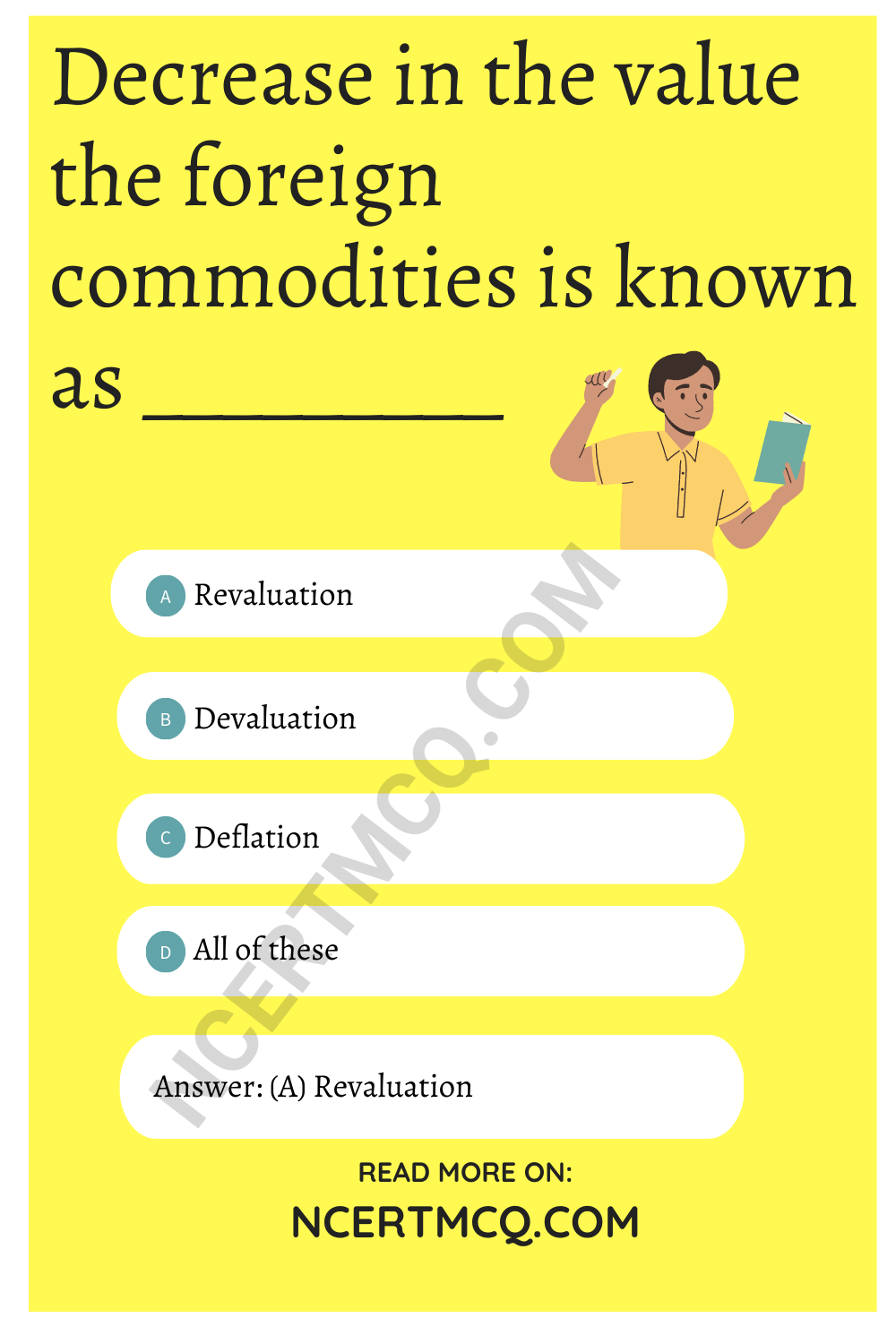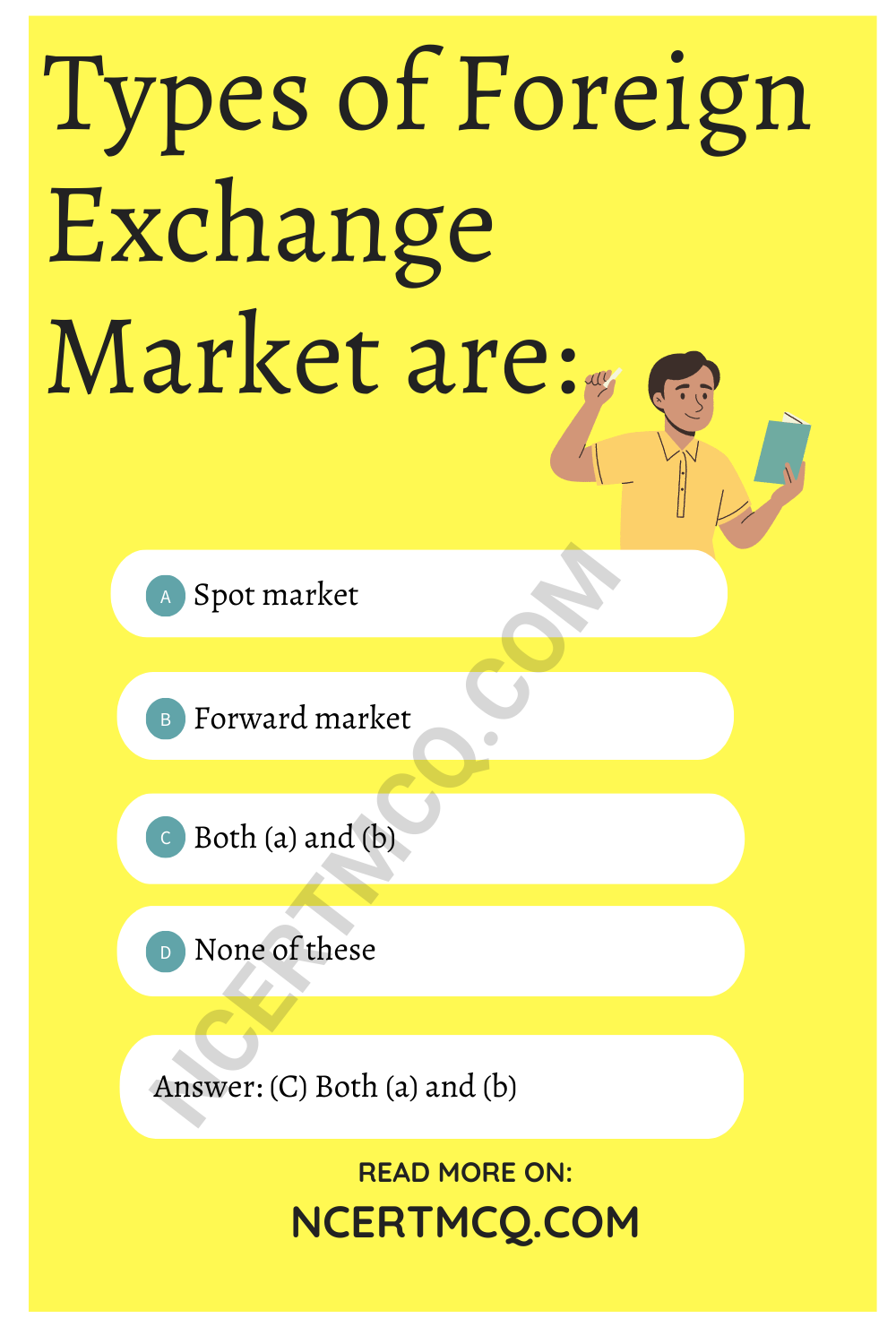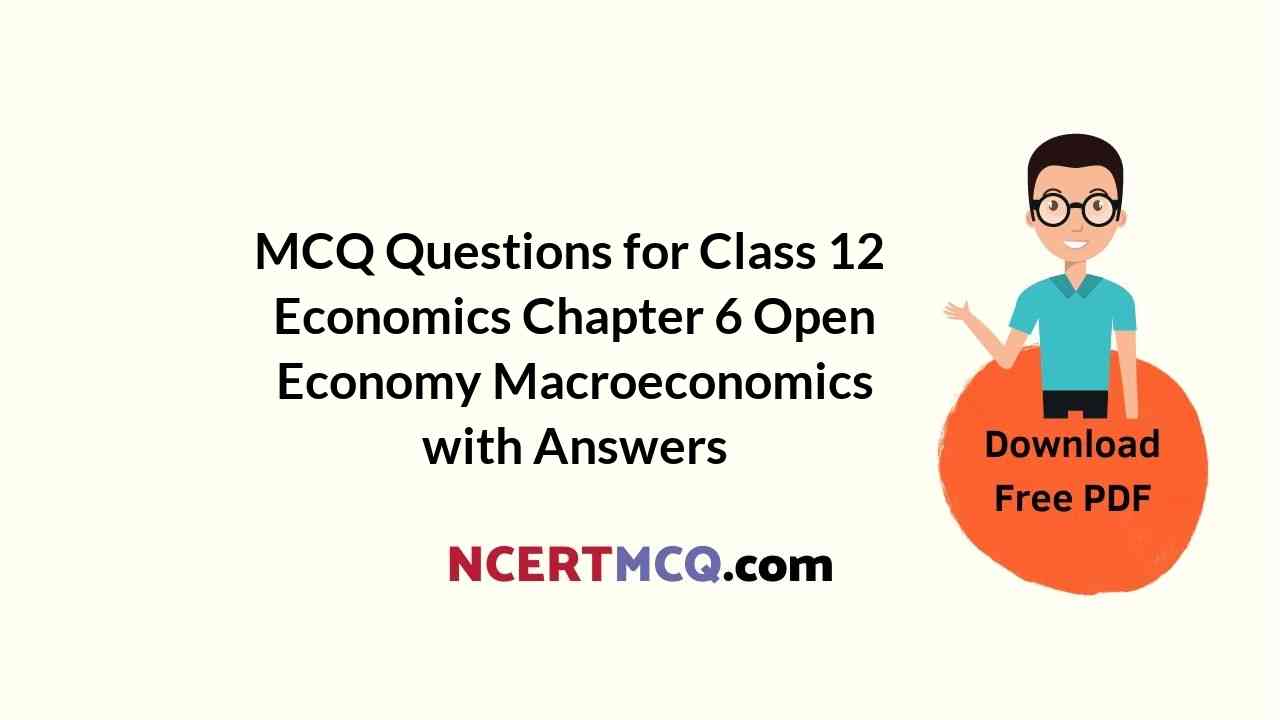Check the below NCERT MCQ Questions for Class 12 Economics Chapter 6 Open Economy Macroeconomics with Answers Pdf free download. MCQ Questions for Class 12 Economics with Answers were prepared based on the latest exam pattern. We have provided Open Economy Macroeconomics Class 12 Economics MCQs Questions with Answers to help students understand the concept very well. https://ncertmcq.com/mcq-questions-for-class-12-economics-with-answers/
Class 12 Economics Chapter 6 Open Economy Macroeconomics MCQ With Answers
Economics Class 12 Chapter 6 MCQs On Open Economy Macroeconomics
Question 1.
The price of one currency in terms of another is known as _________
(A) Foreign exchange rate
(B) Trade rate
(C) Interest rate
(D) Balance of Payment
Answer
Answer: (A) Foreign exchange rate
Question 2.
The market where the national currencies are traded for one another is known as ________
(A) Domestic exchange market
(B) Foreign exchange market
(C) Bazaar
(D) Shop
Answer
Answer: (B) Foreign exchange market
Question 3.
Increase in the value of foreign commodities is known as _________
(A) Revaluation
(B) Devaluation
(C) Inflation
(D) None of these
Answer
Answer: (B) Devaluation
Question 4.
Decrease in the value the foreign commodities is known as _________
(A) Revaluation
(B) Devaluation
(C) Deflation
(D) All of these
Answer
Answer: (A) Revaluation

Question 5.
What is the cause of the devaluation of any country’s currency?
(A) Increase in the domestic inflation rate
(B) Domestic real interest rates are less than foreign interest rates
(C) Much increase in the income
(D) All of these
Answer
Answer: (D) All of these
Question 6.
The operation of daily nature in the foreign exchange market is known as ________
(A) Spot market
(B) Forward market
(C) Domestic market
(D) International market
Answer
Answer: (A) Spot market
Question 7.
The operation of future delivery in the foreign exchange market is known as ________
(A) Spot market
(B) Current market
(C) Forward market
(D) Domestic market
Answer
Answer: (C) Forward market
Question 8.
Hybrid in management of fixed and flexible exchange rate is known as ________
(A) Managed to float
(B) Crawling Peg
(C) Wider Bands
(D) None of these
Answer
Answer: (A) Managed floating
Question 9.
When was the gold standard abandoned?
(A) 1930’s
(B) 1920’s
(C) 1940’s
(D) 1950’s
Answer
Answer: (B) 1920’s
Question 10.
Trade of visible items between the countries is known as ________
(A) Balance of Payment
(B) Balance of Trade
(C) Deficit Balance
(D) All of these
Answer
Answer: (B) Balance of Trade
Question 11.
When the import and export of visible items are equal, the situation is known as _______
(A) Balance of Trade
(B) Balance of Payment
(C) Trade Surplus
(D) Trade Deficit
Answer
Answer: (A) Balance of Trade
Question 12.
When there is a favourable balance of trade?
(A) X > M
(B) X = M
(C) X < M
(D) None of these
Answer
Answer: (A) X > M
Question 13.
When there is unfavourable balance of trade?
(A) X > M
(B) X = M
(C) X < M
(D) None of these
Answer
Answer: (C) X < M
Question 14.
The trade of visible and invisible items is known as _________
(A) Balance of Payments
(B) Balance of Trade
(C) Deficit of interest
(D) Profit
Answer
Answer: (A) Balance of Payments
Question 15.
Other things remaining unchanged, when in a country the price of foreign currency rises, national income is:
(A) Likely to rise
(B) Likely to fall
(C) Likely to rise and fall both
(D) Not affected
Answer
Answer: (A) Likely to rise
Question 16.
Other things remaining the same, when in a country the market price of foreign currency falls, national income is likely:
(A) To rise
(B) To fall
(C) To rise or to fall
(D) To remain affected
Answer
Answer: (B) To fall
Question 17.
Which one is the king of the exchange rate?
(a) Fixed Exchange Rate
(b) Flexible Exchange Rate
(c) Both (a) and (b)
(d) None of the above
Answer
Answer: (c) Both (a) and (b)
Question 18.
Which of the following is true?
(a) Fixed exchange rate is determined by the government
(b) Flexible exchange rate is determined by market forces (demand and supply of foreign exchange)
(c) Both (a) and (b)
(d) None of the above
Answer
Answer: (c) Both (a) and (b)
Question 19.
Which one is a kind of fixed exchange rate?
(a) Gold Standard System of Exchange Rate
(b) Bretton Woods System of Exchange Rate
(c) Both (a) and (b)
(d) None of the above
Answer
Answer: (c) Both (a) and (b)
Question 20.
Which one is a merit of the fixed exchange rate?
(a) Promotes Foreign Trade
(b) Induces Foreign Capital
(c) Increases Capital Formation
(d) All the above
Answer
Answer: (d) All the above
Question 21.
Which one is a demerit of the fixed exchange rate?
(a) Ignores National Interests
(b) Restricted Movement of Capital
(c) Sudden Fluctuations in Exchange Rates
(d) All the above
Answer
Answer: (d) All the above
Question 22.
Which one is a merit of the flexible exchange rate?
(a) Simple System
(b) Continuous Adjustments
(c) Improves Balance of Payments
(d) All the above
Answer
Answer: (d) All the above
Question 23.
Which one is a demerit of the flexible exchange rate?
(a) Bad Results of Low Rate
(b) Uncertainty
(c) Instability in Foreign Exchange
(d) All the above
Answer
Answer: (d) All the above
Question 24.
Which one is a source of the demand for foreign exchange?
(a) Imports of Goods and Services from Abroad
(b) Investment in Foreign Nations
(c) Gift Scheme to Foreign Nations
(d) All the above
Answer
Answer: (d) All the above
Question 25.
Foreign exchange is determined by:
(a) Demand for foreign currency
(b) Supply of foreign currency
(c) Demand and supply in the foreign exchange market
(d) None of the above
Answer
Answer: (c) Demand and supply in a foreign exchange market
Question 26.
The forms of foreign exchange market is/are:
(a) Spot market
(b) Forward market
(c) Both (a) and (b)
(d) None of these
Answer
Answer: (c) Both (a) and (b)
Question 27.
The foreign exchange rate is determined by:
(a) Government
(b) Bargaining
(c) World Bank
(d) Demand and Supply forces
Answer
Answer: (d) Demand and Supply forces
Question 28.
By exchange rate we mean:
(a) How much local currency we have to pay for a foreign currency
(b) How much of a foreign currency we have to pay for another foreign currency
(c) The rate at which foreign currency is bought and sold
(d) All of these
Answer
Answer: (d) All of these
Question 29.
Balance of Trade =?
(a) Export of Visible Items – Imports of Visible Items
(b) Export of both Visible and Invisible Items – Import of both Visible and Invisible Items
(c) Import of Visible Items – Export of Visible Items
(d) None of the above
Answer
Answer: (a) Export of Visible Items – Imports of Visible Items
Question 30.
Which items are included in the Balance of Payments?
(a) Visible Items
(b) Invisible Items
(c) Capital Transfers
(d) All the above
Answer
Answer: (d) All the above
Question 31.
Which one is the visible item of Balance of Payments?
(a) Machine
(b) Cloth
(c) Cement
(d) All of these
Answer
Answer: (d) All of these
Question 32.
Which one is the invisible item of Balance of Payment?
(a) Banking
(b) Shipping
(c) Communication
(d) All of these
Answer
Answer: (d) All of these
Question 33.
Which one is the feature of Balance of Payment?
(a) Systematic Accounts
(b) Fixed Time Period
(c) Comprehensiveness
(d) All the above
Answer
Answer: (d) All the above
Question 34.
Which account is included in the composition of the Balance of Payments?
(a) Current Account
(b) Capital Account
(c) Both (a) and (b)
(d) None of the above
Answer
Answer: (c) Both (a) and (b)
Question 35.
Which one is the item of the Current Account?
(a) Import of Visible Items
(b) Expenses of Tourists
(c) Exports of Visible Items
(d) All the above
Answer
Answer: (d) All the above
Question 36.
Which one is the item of Capital Account?
(a) Government Transaction
(b) Priva Transactions
(c) Foreign Direct Investment
(d) All the above
Answer
Answer: (d) All the above
Question 37.
The component(s) of Balance of Payment is/are:
(a) Current Account
(b) Capital Account
(c) Both (a) and (b)
(d) None of these
Answer
Answer: (c) Both (a) and (b)
Question 38.
Which items are included in the balance of trade?
(a) Invisible Item
(b) Capital Transfer
(c) Visible Item
(d) All of these
Answer
Answer: (c) Visible Item
Question 39.
Balance of Trade means:
(a) Capital Transaction
(b) Import and export of goods
(c) Total debit and credit
(d) All the above
Answer
Answer: (b) Import and export of goods
Question 40.
The reason for the imbalance in the balance of payment is:
(a) Natural Reasons
(b) Economic Reasons
(c) Political Reasons
(d) All of these
Answer
Answer: (d) All of these
Question 41.
Structure of balance of payment includes which account:
(a) Current account
(b) Capital account
(c) Both (a) and (b)
(d) None of these.
Answer
Answer: (c) Both (a) and (b)
Question 42.
Balance of trade means:
(a) Capital transactions
(b)Import and export of goods,
(c) Total credit and debit
(d) All of the above
Answer
Answer: (b)Import and export of goods,
Question 43.
Measures to improve the adverse balance of payment includes:
(a) Currency devaluation
(b) Import substitution
(c) Exchange control
(d) All of the above
Answer
Answer: (d) All of the above.
Question 44.
Foreign Exchange Rate is determined by:
(a) Demand for foreign currency
(b) Supply of foreign currency
(c) Demand and supply in the foreign exchange market
(d) None of these
Answer
Answer: (c) Demand and supply in the foreign exchange market
Question 45.
Types of Foreign Exchange Market are:
(a) Spot market
(b) Forward market
(c) Both (a) and (b)
(d) None of these
Answer
Answer: (c) Both (a) and (b)

Fill in the blanks:
Question 1.
________ refers to the rate at which one currency is exchanged for the other.
Answer
Answer: Foreign exchange rate
Question 2.
_______ rate of exchange refers to the rate of exchange as determined by the government.
Answer
Answer: Fixed
Question 3.
_______ market deals with current sales and purchases of foreign exchange.
Answer
Answer: Foreign Exchange
Question 4.
_______ market deals with such sale and purchase of foreign exchange, which are contracted today but are implemented sometimes in the future.
Answer
Answer: Forward
Question 5.
Balance of ________ is a summary statement of all economic transactions between a country and the rest of the world.
Answer
Answer: Payment
Question 6.
The balance of _______ is the difference between visible exports and visible imports.
Answer
Answer: Trade
Question 7.
Balance of Payment is always _________
Answer
Answer: Positive
Question 8.
Balance of Payment is a ______ concept as compared to the balance of trade.
Answer
Answer: broader
Question 9.
If exports exceed imports, then BoP is _________
Answer
Answer: favourable
Question 10.
Balance of trade includes only ________ items.
Answer
Answer: visible
Question 11.
Bretton woods system is also known as ________ border system.
Answer
Answer: Adaptable
Question 12.
There is ________ relation between foreign exchange rate and the supply of foreign exchange.
Answer
Answer: Direct
Question 13.
By devaluation, the value of currency ________
Answer
Answer: Reduces
Question 14.
________ items are included in the balance of trade.
Answer
Answer: Visible
Question 15.
Balance of payment always remains ________
Answer
Answer: Balanced
Question 16.
The value of the currency of one country with that of the currency of another country is called ________
Answer
Answer: Exchange rate
State true or false:
Question 1.
Balance of Payments includes only visible items.
Answer
Answer: False
Question 2.
Balance of trade is a part of the Balance of Payments.
Answer
Answer: True
Question 3.
The balance of trade is always positive.
Answer
Answer: False
Question 4.
The balance of Payments may be positive or negative.
Answer
Answer: False
Question 5.
The current account records visible items, invisible items, and unilateral transfers.
Answer
Answer: True
Question 6.
Capital account records are such transactions, which cause a change in the asset and liability status of the residents of a country or of its government.
Answer
Answer: True
Question 7.
Exports of tea is an example of visible items.
Answer
Answer: True
Question 8.
Banking and insurance are examples of visible items.
Answer
Answer: False
Question 9.
Forward market deals with current sales and purchases of foreign exchange.
Answer
Answer: False
Question 10.
Demand for foreign exchange also depends upon payments of international loans.
Answer
Answer: True
Question 11.
Balance of trade includes both visible and invisible items.
Answer
Answer: False
Question 12.
Balance of trade is a part of the Balance of payments.
Answer
Answer: True
Question 13.
Devaluation is declared by the government.
Answer
Answer: True
Question 14.
The balance of payment is always balanced.
Answer
Answer: True
Question 15.
For export promotion, the help of devaluation is taken.
Answer
Answer: True
Question 16.
The increasing population in developing countries has a direct impact on economic growth.
Answer
Answer: False
Question 17.
Export promotion is one of the ways of correcting the Balance of payments.
Answer
Answer: False
Match the following:
Question 1.
| ‘A’ | ‘B’ |
| 1. Balance of payments | (a) Always favourable |
| 2. Balance of Trade includes | (b) Both visible and invisible items |
| 3. India’s Balance of payments | (c) Includes only visible items |
| 4. Determination of flexible exchange rate | (d) Foreign banks issue letter of credit in large demand over banks of the country |
| 5. In favour of foreign exchange rate | (e) Forces of demand and supply in foreign exchange markets. |
Answer
Answer:
| ‘A’ | ‘B’ |
| 1. Balance of payments | (b) Both visible and invisible items |
| 2. Balance of Trade includes | (c) Includes only visible items |
| 3. India’s Balance of payments | (a) Always favourable |
| 4. Determination of flexible exchange rate | (e) Forces of demand and supply in foreign exchange markets. |
| 5. In favour of foreign exchange rate | (d) Foreign banks issue letter of credit in large demand over banks of the country |
Question 2.
| Column-I | Column-II |
| 1. Spot market | (A) Risk management |
| 2. Forward market | (B) Accommodating items |
| 3. Hedging | (C) Deals with current transactions |
| 4. Above the line items | (D) Autonomous items |
| 5. Below the line items | (E) Deals with future transactions |
Answer
| Column-I | Column-II |
| 1. Spot market | (C) Deals with current transactions |
| 2. Forward market | (E) Deals with future transactions |
| 3. Hedging | (A) Risk management |
| 4. Above the line items | (D) Autonomous items |
| 5. Below the line items | (B) Accommodating items |
Answer:
We hope the given NCERT MCQ Questions for Class 12 Economics Chapter 6 Open Economy Macroeconomics with Answers Pdf free download will help you. If you have any queries regarding CBSE Class 12 Economics Open Economy Macroeconomics MCQs Multiple Choice Questions with Answers, drop a comment below and we will get back to you soon.
Class 12 Macroeconomics with Answers MCQ:
